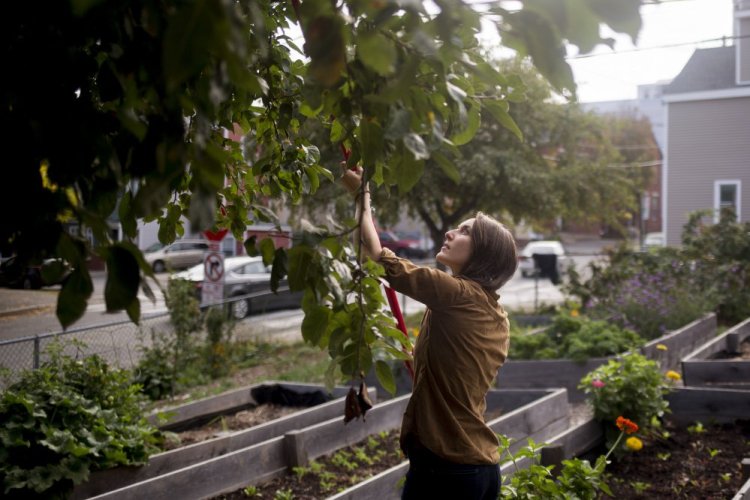Kayla Blindert wrapped up her year-long AmeriCorps assignment in Portland in August, but she opted to stick around through the harvest because she’s got a gleaning project she’s excited about. As the first-ever Maine Gleaning Week approaches, we called her up to talk farms, fruit and how Portland residents can help feed the hungry just by opening their garden gates.
WALK THIS WAY: When Blindert signed up for AmeriCorps, she requested Maine for her assignment. Why? The South Dakota native has a thing for New England architecture, and Portland offered another bonus. “I used to live in Spain, and living abroad you are forced to live without a car, and I really liked living without a car, so I thought I am going to choose a city where I can walk everywhere.”
MAP BUILDING: Blindert’s AmeriCorps position is with the Cumberland County Food Security Council, where she serves as the gleaning coordinator. She’s been arranging gleans at local farms all summer, including Jordan Farm in Cape Elizabeth and Two Farmers Farm in Scarborough. But the legacy she wants to leave behind – her AmeriCorps gig is focused on starting initiatives within a community and getting them on the course to being self-sustaining – is one with a more urban bent – a map of fruit-gleaning possibilities. She’s looking for hidden gleaning opportunities in urban backyards, ones she’s noticed as she rides her bike around the city, namely fruit trees filled with apples and pears. “Just on Munjoy Hill, I know there are a bunch of them.” She’s not scaling any fences to poach fruit; she’s looking for landowners willing to offer their trees for gleaning.
THROUGH THE GRAPEVINE: She’ll take Concord grapes or other varieties as well. “If the fruit is edible and delicious, I’m more than happy to include that tree in our database/map.”
THEM APPLES: The first step in the project (done in conjunction with Cumberland County University of Maine Cooperative Extension and the Food Recovery Coalition) has been reaching out to homeowners through neighborhood associations, specifically to people who might otherwise let the food go to waste. As Blindert assesses the backyard fruit possibilities, she’s open to the less than perfect. “The woman I am going to see tomorrow says she has McIntosh but that they are pie apples and not pristine.” Blindert is coordinating with Wayside Food Programs to explore options like making applesauce or apple cider for the food bank. The grand scheme is to establish what’s out there for next year and the year beyond. She’ll take a photo of the tree (with its owner) and the fruit, establish a location on the map and have the photos, along with samples of the fruit, on display at the Portland Public Library on World Food Day, Oct. 16, as Maine Gleaning Week concludes. The map, or database, will be accessible to those in the Maine Gleaning Network, but is not a public document.

Kayla Blindert works in the Cultivating Communities garden on Oxford Street.
LOVE FEST: Blindert grew up on a farm in Salem, South Dakota, where her family plants corn and soybeans and raises cattle. “It’s not like giant, though.” She calls it a typical Midwestern farm, but says that doesn’t mean it fits with the stereotype held by many Easterners: miles and miles of corporate-owned mono crops. Her two brothers work on the farm, along with her cousins and uncle. But it is pretty different from the Maine farming community Blindert sees (and appreciates) in her gleaning work. “I like small, diversified vegetable farms. I love Maine Farmland Trust. I love what they do. And that the community really cares about where their food comes from.”
AT THE MARKET: She gets firsthand exposure to that at the Portland Farmers’ Market, where she took a second job, working at the information booth. “I wanted to get to know farmers, so that I could improve my chances of getting them to let me glean on their farms.” Her responsibilities at the booth include helping those with SNAP (Supplemental Nutrition Assistance Program) use their EBT cards at the market, which gives them double the value for their dollar on some purchases. “It always feels like every Wednesday I am explaining it to someone new.” And it’s rewarding: “They are so excited to get all this extra money.”
PERSONAL PERSPECTIVE: She knows what she’s talking about with SNAP benefits. “Since I am in AmeriCorps, I qualify because we are paid at the poverty line.” Thus she gets to put programs like Harvest Bucks to work in her own kitchen. There’s some public sentiment that SNAP beneficiaries don’t work. “Me and my friends all work 40 hours a week.”
WHAT’S NEXT? Since she likes Maine so much, is she going to stick around? Probably not for the winters. “The winter months are a little too much with those snow bands. I might just go visit my friends in Spain for the winter.”
PUTTING YOU ON THE MAP: Do you have fruit trees that need picking? Contact Blindert through gleaning@ccfoodsecurity.org, and your trees may be added to the gleaning network’s map.
Mary Pols can be contacted at 791-6456 or at:
Twitter: MaryPols
Send questions/comments to the editors.




Success. Please wait for the page to reload. If the page does not reload within 5 seconds, please refresh the page.
Enter your email and password to access comments.
Hi, to comment on stories you must . This profile is in addition to your subscription and website login.
Already have a commenting profile? .
Invalid username/password.
Please check your email to confirm and complete your registration.
Only subscribers are eligible to post comments. Please subscribe or login first for digital access. Here’s why.
Use the form below to reset your password. When you've submitted your account email, we will send an email with a reset code.